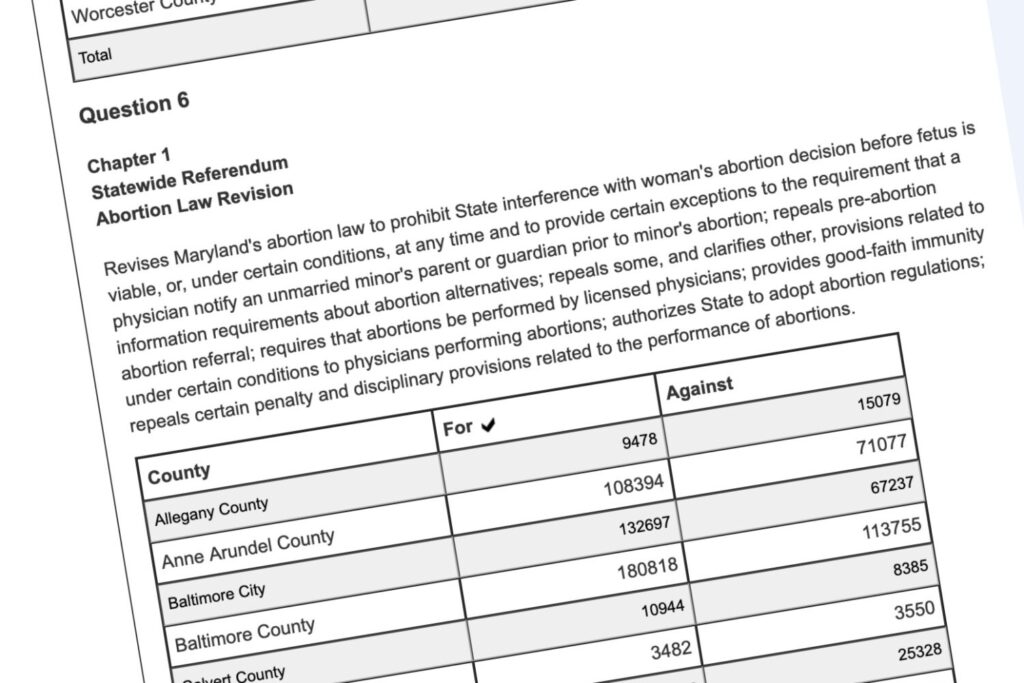
Results of the 1992 abortion referendum, when opponents tried unsucessfully to overturn a state law that codified the protections of Roe v. Wade. Screenshot from Maryland State Board of Elections.
When Marylanders go to the polls Tuesday to decide the future of abortion rights in the state, it won’t be for the first time.
More than 30 years ago, when it looked like Roe v. Wade, the Supreme Court ruling that recognized a right to an abortion, was in danger of being overturned, the General Assembly passed a law codifying the protections of Roe. That law was petitioned to referendum by abortion opponents in 1992, ending a two-year fight that began with a draining and emotional filibuster that brought business to a halt in the 1990 Senate for eight days.
“It was a very difficult and emotional time in the Senate,” said Phillip C. Jimeno, who was a Democratic senator from Anne Arundel County at the time. He was among the 16 senators, most of them Democrats, who mounted the filibuster to block the legislation liberalizing abortion laws.
“It was not a partisan issue, it was philosophical,” Jimeno said recently.
Paula Hollinger, who was a Democratic senator from Baltimore County at the time, sponsored the 1990 legislation to codify Roe.
“Unlike most political debates, which often fell along party lines, there were Irish Catholic Democrats who were staunchly opposed to abortion, while some Republicans were pro-choice,” said Hollinger, who was a registered nurse.

Emotions were running high. Hollinger remembers one morning when she discovered someone had placed small, plastic fetuses on the desks of pro-choice senators. She said whomever was responsible was never identified.
Jimeno said opponents offered multiple amendments, including one from him that “would have required parental consent before underage girls would be allowed to get an abortion,” but most of the amendments were rejected by the non-filibustering majority.
Once senators had exhausted discussion on the abortion issue, Jimeno said, they resorted to reading phone books, bus schedules and virtually anything else to sustain the filibuster.
“We had constituents who brought food to Annapolis and prayed in the Senate gallery to support us,” he said. The marathon sessions often dragged on until 2 a.m. and then resumed the next morning.
Years later, Senate President Mike Miller told reporters the filibuster “was ugly. People (abortion opponents) were talking about the Holocaust.”
Miller, who died in 2021, found himself in the middle of the contentious debate as Senate president in 1990. While personally opposed to abortion, he spent days and nights pleading with anti-abortion colleagues to end the marathon debate, which forced a complete shutdown of other legislative business.
Finally, on the eighth day, Miller convinced enough senators to formally cut off extended debate to end the filibuster. The Senate eventually enacted a compromise abortion bill that session, but the House of Delegates failed to enact it.
The following year, the General Assembly quickly passed legislation guaranteeing the right to an abortion until the fetus reaches viability, which is usually around 24 weeks. Within an hour of passage, the bill was signed into law by then-Gov. William Donald Schaefer.
Abortion opponents were undeterred. Led by former Lt. Gov. Samuel W. Bogley III, they launched a successful petition drive that put the issue on the 1992 ballot for voters to decide. Bogley served just one term as Gov. Harry Hughes’ lieutenant governor: Hughes, who supported abortion rights, dropped Bogley from the ticket in the second term.
Political ads on both sides saturated the airwaves weeks before the election. One television commercial, sponsored by an anti-abortion group, featured Dr. Ben Carson, a Johns Hopkins neurosurgeon who would enter national politics as a Republican candidate for president decades later.
On Election Day 1992, Maryland voters overwhelmingly approved the referendum question 62% – 38%.
Some of the Democratic senators who took part in the anti-abortion filibuster were subsequently targeted for defeat by abortion rights groups. They included three-term Sen. Francis X. Kelly Jr. (D-Baltimore County), who was defeated in the 1990 Democratic primary by Janice Piccinini in a campaign she focused primarily on supporting abortion rights.

Jimino said he is not sure if the filibustering senators of 1990 would do the same today, given how far some states have pushed their abortion restrictions.
“When some states passing such restrictive abortion language, I don’t know if any of us would have stood up to defend the actions of those states today,” he said, citing restrictive abortion laws in Florida, Texas, Louisiana and other states. “The problem is they’ve (other states) have gone so extreme in charging the physicians in some cases, and women have had to go out of state to get abortions.”
As an example, Jimeno cites his wife, who underwent a tubular pregnancy many years ago.
“Under some of these laws, physicians would have been charged, and my wife may not have been alive today. That’s what’s restricted under some of these abortion laws,” he said.
This year’s abortion debate comes after the Supreme Court has overturned Roe v. Wade, but this time it is abortion-rights advocates who put it on the ballot, not opponents. And this time, they are seeking to enshrine those protections not just in state law, but in the state constitution.
Baltimore Archbishop William Lori has urged Catholic voters to vote no on Question 1, the question in this year’s fight. Lori’s letter said a constitutional amendment is both unnecessary and harmful, “because it would divert resources away from the well-being of women, children and families.”
But Delegate Samuel “Sandy” Rosenberg (D-Baltimore City), who has been in office for more than 40 years, vividly remembers the contentious 1990 debate and the 1992 voter referendum. Rosenberg, a staunch abortion rights supporter, said approving reproductive rights in the Maryland constitution is more consequential.
“The Dobbs decision (which overturned Roe vs. Wade) teaches us that you can’t take this for granted. A constitutional provision is a stronger protection for reproductive freedom than a statute,” Rosenberg said.

